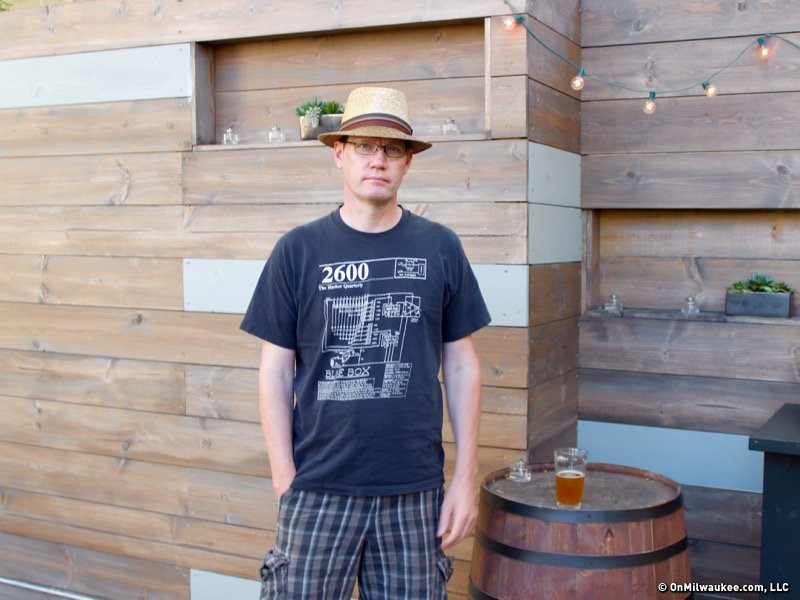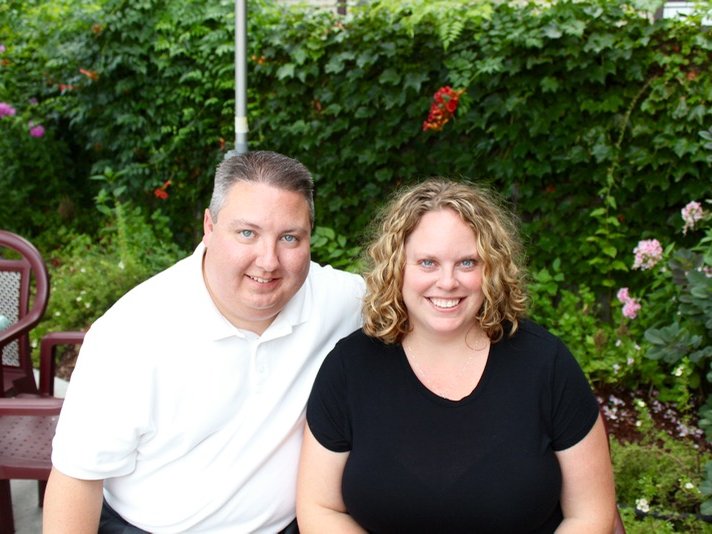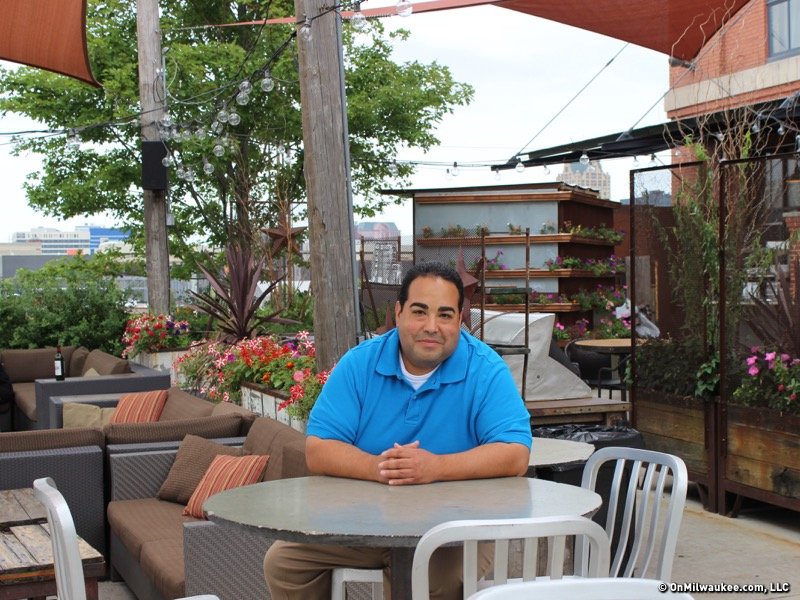Milwaukee is filled with amazing people. And some of those people are wild about food. 8 Questions is a series that focuses on food lovers in our midst. They aren’t chefs. They don’t work in the food industry. But, they know a thing or two about eating. And that’s part of what makes them awesome.
By day, Bryan Peters works remotely as the global operations manager for security service at IBM. But, by night -- and on weekends -- you’re likely to find him engaged in his pursuit of locally grown and harvested food products or in the kitchen cooking up new ways to eat pork.
If you frequent the West Allis Farmer’s Market or the Milwaukee County Winter Market, you may have run into Peters at the stand for Jen Ehr Farm, where he is a welcome source of information about how to use some of the more unusual vegetable varieties they carry.
Peters grew up in an air force family, spending the bulk of his life hopping from city to city in the southern U.S. When Peters was in high school, his father was transferred to Europe. During the three years his family spent in Greece, he developed a taste for a wide variety of foods, including Mediterranean and European fare.
After graduating with a computer science degree from the University of Georgia, Peters eventually landed a job with Mindspring ISP, where he met his wife, Jen. After they got married and began to talk about starting a family, they made the decision to move to Milwaukee to be closer to Jen’s family.
Peters says the move left him feeling lonely and isolated; so, he started looking for ways to make connections in the area. It turns out food was the answer.
"About a year after moving to Milwaukee, we connected with Jen Ehr at the Urban Ecology Center’s Farmer Open House," says Peters. "We bought a CSA, and about half-way into our first season with the farm, Kay [Jensen] mentioned she needed help at the market."
"Since then, I’ve become very passionate about CSA’s and the concept of local eating," Peters goes on. "I spend a lot of my time talking with people about foods they’re not familiar with. Making those connections at the market is one of the best things that’s ever happened to me."
When he’s not cooking, eating or tending his West Allis garden, you’ll find Bryan perusing the hats at Brass Rooster in Bay View, contemplating additions to his growing collection of fashionable headwear.
What inspired your love of food?
After living in Greece, I returned to Georgia to attend college… I literally moved from Athens to Athens. While I was in school, I worked in various restaurants, primarily pub-type spots.
Before I finished school and really started my career I worked in an authentic Mexican restaurant where the muse was cookbook author Diana Kennedy. That was my first exposure to really cooking something that was worth talking about. I got to understand the cultural dishes of Mexico a bit more, and it made me feel something… food began to matter more.
At that point, I started to want to be more authentic in my cooking, to get as close to the source as I could. It was a major inspiration.
What are some of your favorite things to cook?
Because of my southern background, I have a soft spot for Mexican cuisine. And, thanks to my exposure to Diana Kennedy, I tend to focus on Aztec dishes.
While I’m comfortable with a variety of other cuisines, mostly European, I can’t cook Chinese food to save my life, even with a recipe. Normally when I cook, I understand how the ingredients are going to react and what the end product will be. But, Chinese is a completely different set of techniques, and I just can’t get it right. So, I avoid it.
One very special dish I make is Diana Kennedy’s red mole. I don’t do it often, since it’s pretty involved; but when I do, it’s lovely. And I always prepare a huge batch.
Seems you’ve traveled a bit. Do you have a favorite food city?
I was very recently in San Francisco and I ate the pants off that town. I also once went to Vegas and spent all the money I’d saved up to buy a kegerator on a whirlwind tour of celebrity chef spots.
But, my favorite kind of restaurant, really, is a shack with a smoker in the back and paper bags. You know -- the quintessential barbeque shack. The dirtier the shack, the better the ribs - south of the Mason Dixon line anyhow.
Do you have a favorite Milwaukee restaurant?
Jen and I, for special occasions, generally go to La Merenda. Peter [Sandroni] is such a fantastic person, in terms of how he supports the local farms and local food sources. And what he does with his food … he’s an inspiration. His dishes are always fabulous.
One of my favorite things to eat there is the grass-fed beef tenderloin with chimichurri and mashed plantains… I’ll order two and eat them both. So good.
What’s your favorite "secret" food spot?
You know, Mia Famiglia was always a great spot that we liked. Chef Tom [White Jr.] makes a cioppino that melts my wife’s heart. And he just does amazing things with seafood, generally.
They’ve since moved out of Hales Corners and to Waukesha. It’s now a half-hour drive, so although we have been to the new restaurant, I don’t know that we’ve really replaced that as our go-to.
Is there anything that frustrates you about being a food lover in Milwaukee?
In Atlanta, it was very easy to go out and get different foods I needed for cooking. There were a variety of ethnic supermarkets around my house.
Here it seems to me that the minute I find an ethnic grocery store that’s conveniently located, it disappears. There was an Indian grocer near my house where I bought ingredients for a while, and now it’s gone. There was also an Asian grocer nearby that also isn’t there anymore.
Finding collard greens and other southern favorites is also a challenge. So, I grow my own.
For a long time, I couldn’t find okra anywhere. This summer I finally found a source, and I couldn’t be more excited. Kettle Rock Farms at the Wauwatosa Farmer’s Market grows okra. And, even better, they’re getting their organic certification later in August. So, that’s awesome.
What’s the most memorable dish you’ve ever eaten?
One evening that stands out in my memory -- and always will -- was when we first moved to Greece. The guy that my father was replacing took us out to a taverna, and the spread they laid out… it was amazing. The seafood was so fresh, and there was so much of it. And I’d never had anything like that before.
It was just really like this "high water mark." There were head-on prawns just stacked on top of one another. Clams and other fish. Just so fresh. It was unbelieveable. I was a teenager at the time -- maybe 14 years old -- and it just blew my mind. And I don’t know if I ever had a meal that good there again.
Talk to me about one of your best food adventures:
My adventures tend to revolve around pork.
About four years ago, I got a hold of Fergus Henderson’s book "The Complete Nose to Tail." And I really wanted to take advantage of some of the pork products that people tend to disregard -- ears, tails, trotters, caul fat. So, I bought a whole pig and had it butchered.
I was even lucky enough to have had an opportunity to catch the blood from my pig during the process. So much is regulated about the process… so it was pretty complicated. For instance, you’re really not allowed to procure pigs’ blood from butchers. So, I had to do it myself. I met my pig where it was being butchered and they allowed me onto the killing floor. I had to stand next to the pig to gather it myself -- because they couldn’t do it for me.
It was really an experience. I got to see the butchering process firsthand and it gave me an even greater respect for both my food and the people who do the work of slaughtering animals.
One bonus question: What did you do with the blood?
Henderson has a recipe for blood cake, which is essentially a meatloaf made from blood and fat. I made it, and it had a strong flavor of offal -- milder than liver -- but similar to sweetbreads. I made the cake, cooled it and sliced it into pieces and fried it like you might foie gras. Of course, no one else in my family would eat it. Same thing when I made kidney pudding.
The following year, we butchered our own pig at home -- from prime quarters -- and that gave me respect for that process. I’d never do that again -- and not because I was turned off by it -- because it was real work. Cutting pork chops really isn’t easy. And it really made me appreciate that I can’t have everything I want from one animal. Decisions have to be made with cuts; I can’t have boneless loin and pork chops, for instance.
Recently, I did make some of my own sausage for the first time. I made a Middle Eastern sausage with Yemeni seasoning. I made it quite mild, so it wasn’t too spicy for the kids. During the process, I did learn a lesson about grinding pork. Essentially, you need to cut up the meat, season it, and then freeze it. The frozen meat works so much better than the unfrozen. It’s just awful, really, if you don’t freeze it first.
Lori is an avid cook whose accrual of condiments and spices is rivaled only by her cookbook collection. Her passion for the culinary industry was birthed while balancing A&W root beer mugs as a teenage carhop, fed by insatiable curiosity and fueled by the people whose stories entwine with each and every dish. She’s had the privilege of chronicling these tales via numerous media, including OnMilwaukee and in her book “Milwaukee Food.” Her work has garnered journalism awards from entities including the Milwaukee Press Club.
When she’s not eating, photographing food, writing or recording the FoodCrush podcast, you’ll find Lori seeking out adventures with her husband Paul, traveling, cooking, reading, learning, snuggling with her cats and looking for ways to make a difference.







